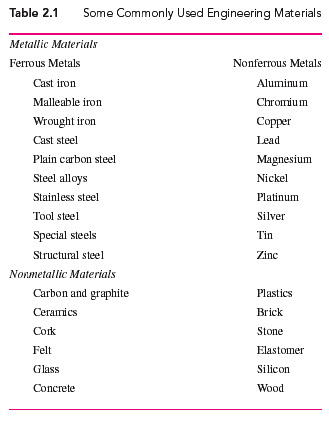A great variety of materials has been produced and more are being produced in seemingly
endless diversification. Material may be crystalline or noncrystalline.Acrystalline material
is made up of a number of small units called crystals or grains. Most materials must be
processed before they are usable. Table 2.1 gives a general classification of engineering
materials. This book is concerned with the macroscopic structural behavior: Properties are
based on experiments using samples of materials of appreciable size. It is clear that a
macroscopic structure includes a number of elementary particles forming a continuous and
homogeneous structure held together by internal forces. The website at www.mathweb.com
offers extensive information on materials.
In this chapter, the mechanical behavior, characteristics, treatment, and manufacturing
processes of some common materials are briefly discussed. A review of the subject matter
presented emphasizes how a viable as well as an economic design can be achieved. Later
chapters explore typical material failure modes in more detail. The average properties of selected
materials are listed in Table B.1 [1-7]. Unless specified otherwise, we assume in this
text that the material is homogeneous and isotropic. With the exception of Section 16.7, our
considerations are limited to the behavior of elastic materials. Note that the design of plate
and shell-like members, for example, as components of a missile or space vehicle, involve
materials having characteristics dependent on environmental conditions [8-10]. We refer to the ordinary properties of engineering materials in this volume. It is assumed that the reader
has had a course in material science [11].
|  <a onClick="window.open('/olcweb/cgi/pluginpop.cgi?it=jpg:: ::/sites/dl/free/007242155x/69897/chap02intro_figure1.jpg','popWin', 'width=379,height=491,resizable,scrollbars');" href="#"><img valign="absmiddle" height="16" width="16" border="0" src="/olcweb/styles/shared/linkicons/image.gif"> (31.0K)</a> <a onClick="window.open('/olcweb/cgi/pluginpop.cgi?it=jpg:: ::/sites/dl/free/007242155x/69897/chap02intro_figure1.jpg','popWin', 'width=379,height=491,resizable,scrollbars');" href="#"><img valign="absmiddle" height="16" width="16" border="0" src="/olcweb/styles/shared/linkicons/image.gif"> (31.0K)</a> |

